The belly of the fish I was holding in a nameless rill high in Great Smoky Mountains National Park glowed with impossible shades of orange. Underfins were trimmed with ivory; chestnut flanks bore specks of ruby ringed with sapphire. Brook trout can exceed two feet in length, but at 7.7 inches this one was big for its habitat. Recovered from its recent jolt, it shot back into the icy flow.
Park biologist Matt Kulp had electro-shocked it in his search for much larger rainbow trout stocked decades earlier when “a trout was a trout” and quality was measured by weight. In the park’s headwaters Kulp and his colleagues have been shocking rainbows and tossing them below impassible falls or, in bigger water also sealed by falls, killing them with short-lived poison. That’s because brook trout belong here and rainbows, from the Pacific Northwest, don’t. So far, the natives have been restored to 27.6 miles of 11 park streams. But this older race of brook trout, unique to the southern Appalachians, has been extirpated from 95 percent of its habitat.
Everywhere in the species’ natural U.S. range, from Georgia to Maine and as far west as Iowa, there is less and less of what it needs most — cold, clean water. The brook trout’s scientific name, Salvelinus fontinalis, translates to “dweller of springs.” Brook trout in America (and even Canada) are being lost to habitat damage and alien fish.
But recovery work is underway. On the warm, windless morning of December 23, 2015 I toured Red Brook in Plymouth, Massachusetts with Steve Hurley, regional fish manager for the state Division of Fisheries and Wildlife, and Warren Winders and Geof Day of the Sea Run Brook Trout Coalition.
Where brook trout have access to the ocean they’ll take advantage of that rich environment. Reversing the growth cycle of landlocked fish, these “salters” fatten in winter, then find summer refuge from striped bass, bluefish and ospreys in freshwater. Red Brook’s salters would have been lost to cranberry culture had not passionate angler Theodore Lyman bought much of the watershed in 1870.

In the early 1990s, when Winders, Day and other advocates urged the Division of Fisheries and Wildlife to protect Red Brook’s native trout, they were told that such fish didn’t exist. When they showed them to the Division they were told that the fish were merely offspring of hatchery trout. When genetic analysis by a graduate student proved Red Brook salters were not only distinct from hatchery stock but also from other salters the Division became a believer and protector.
Salters are endangered in fact, if not by official decree; and Hurley, a biologist of the new breed, manages them accordingly. He reintroduces them to streams where they’ve been extirpated. And he oversees habitat work by the Sea Run Brook Trout Coalition and Trout Unlimited, including the planting of streamside vegetation, log insertion and restoration of pools and riffles.
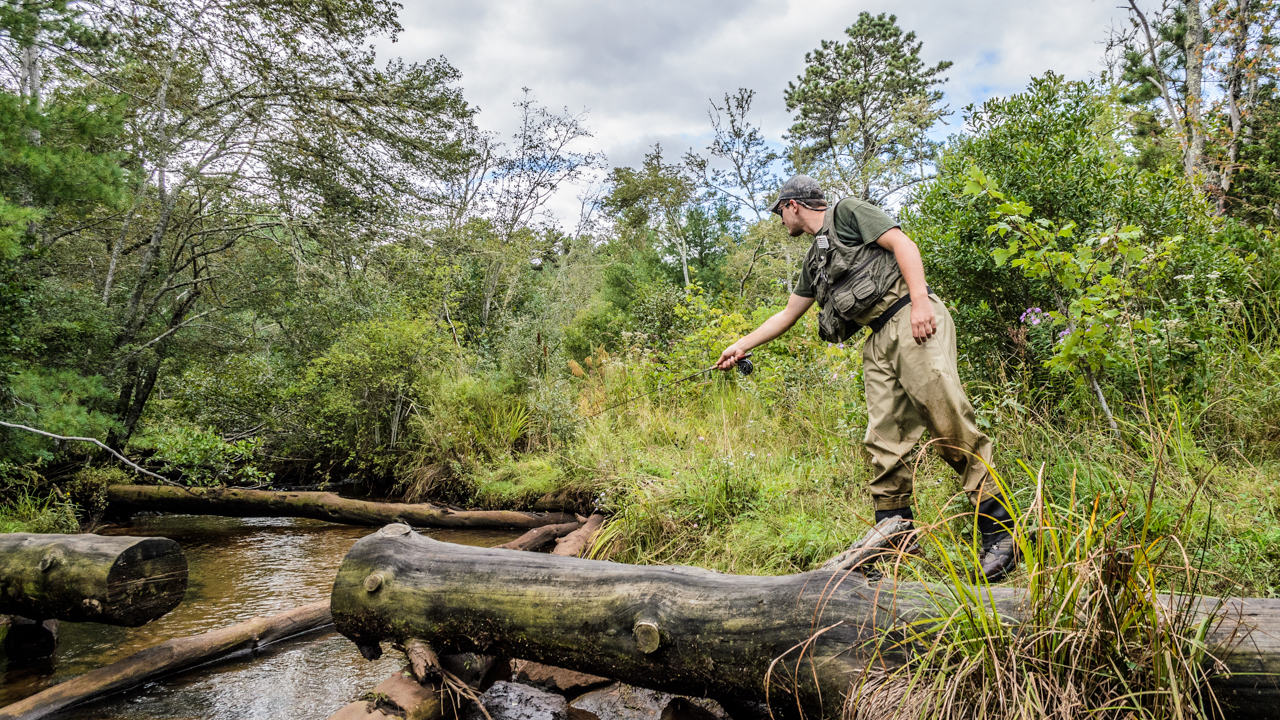
Where Red Brook curls trough an ancient cranberry bog, now rife with sweetgale, blueberry, alder, scrub oak, pitch pine and bull briar, Hurley hitched his laptop to a monitor that records the presence of trout injected with tiny PIT (passive integrated transponder) tags. In the previous six days 78 fish had passed the station. Upstream we came across remains of one of four dams removed by Trout Unlimited, the Division of Fisheries and Wildlife and Trustees of Reservations.
Red Brook’s salters thrive because of this habitat work, because the land around its 4.5-mile course is protected by the Division and Trustees, and because fishing is strictly catch-and-release.
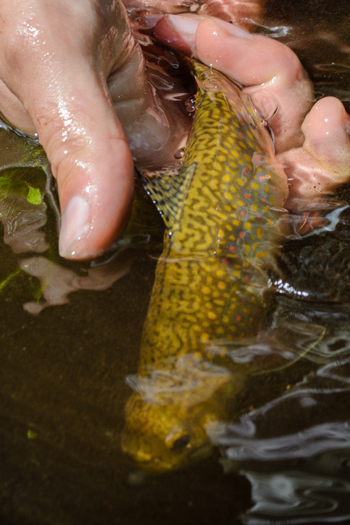
Other once-famous salter streams, some fished by U.S. presidents, haven’t been so lucky. This past fall when Hurley sampled the Santuit River on Cape Cod he found that the population had blinked out. It had, he said, succumbed to “death by a thousand cuts,” not the least of which was water withdrawal by the Willowbend Golf Course and associated development. The day before my tour of Red Brook Geof Day had encountered a maintenance crew armed with chainsaws and shrub cutters waist-deep in the Santuit, supposedly making it “safe” for herring by removing the brush and woody debris salters (and herring, too) need for shade and cover.
Landlocked brook trout, also gravely diminished, have a wider distribution. In 2006 federal and state agencies, local governments, conservation organizations, businesses, scientists and citizens formed a recovery partnership called the Eastern Brook Trout Joint Venture. Matching funds for projects are provided by the U.S. Fish and Wildlife Service. So far, 78 have been approved.
Much of the work involves connecting fragmented habitat. Water scours deep holes when it shoots through tight culverts, leaving them hanging and inaccessible to trout seeking refuge in cool headwaters during summer, a need accentuated by global warming. The Nature Conservancy assesses culverts to determine which ones impede fish and other aquatic organisms.
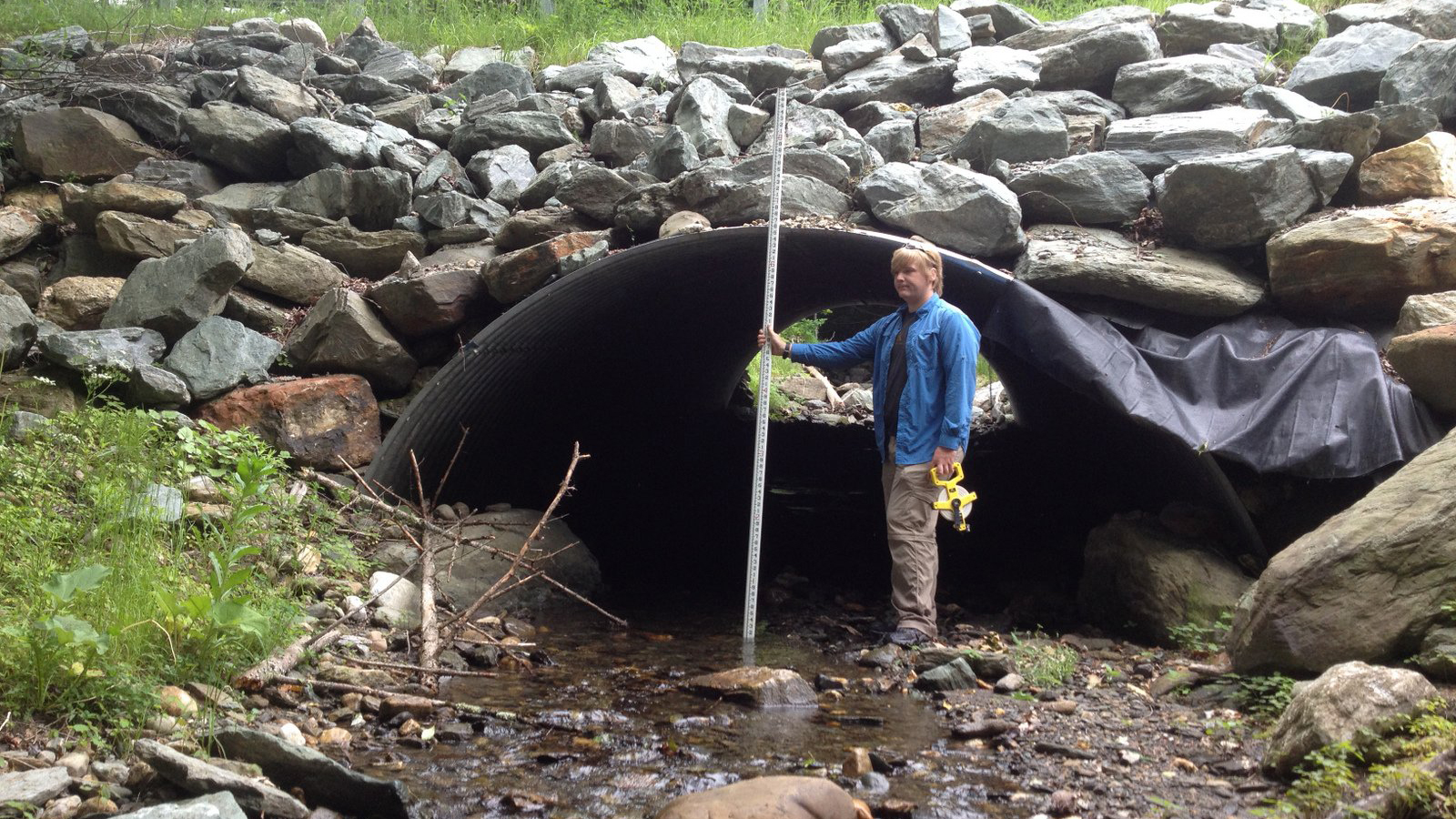
In 2011 Tropical Storm Irene blew out undersize culverts all across the Northeast, at least 1,000 in Vermont alone. That provided an opportunity to replace many with “stream-simulation culverts,” funded in part by the Joint Venture. These span the stream and are lined with its natural substrate. The Green Mountain National Forest had installed a few before Irene, and they survived the flood.
Brook trout recover fast from storms, but not from humans who re-engineer coldwater habitat in vain attempts to make it “flood proof.” After Irene, municipal and state highway departments in New York and New England applied their training to trout streams — that is, they operated on them as if they were highways. They razed riparian vegetation, bulldozed bottoms flat, widened channels, excised pools, riffles and meanders, gouged out gravel and woody debris, then sealed off floodplains by dumping the “spoil,” as they called it, along banks. Hundreds of trout streams were converted to straight, lifeless sluiceways that endangered people downstream by blasting water onto their property. On Massachusetts’ Chickley River, for example, the Town of Hawley unlawfully gutterized 4.5 miles of the state’s best brook-trout habitat.
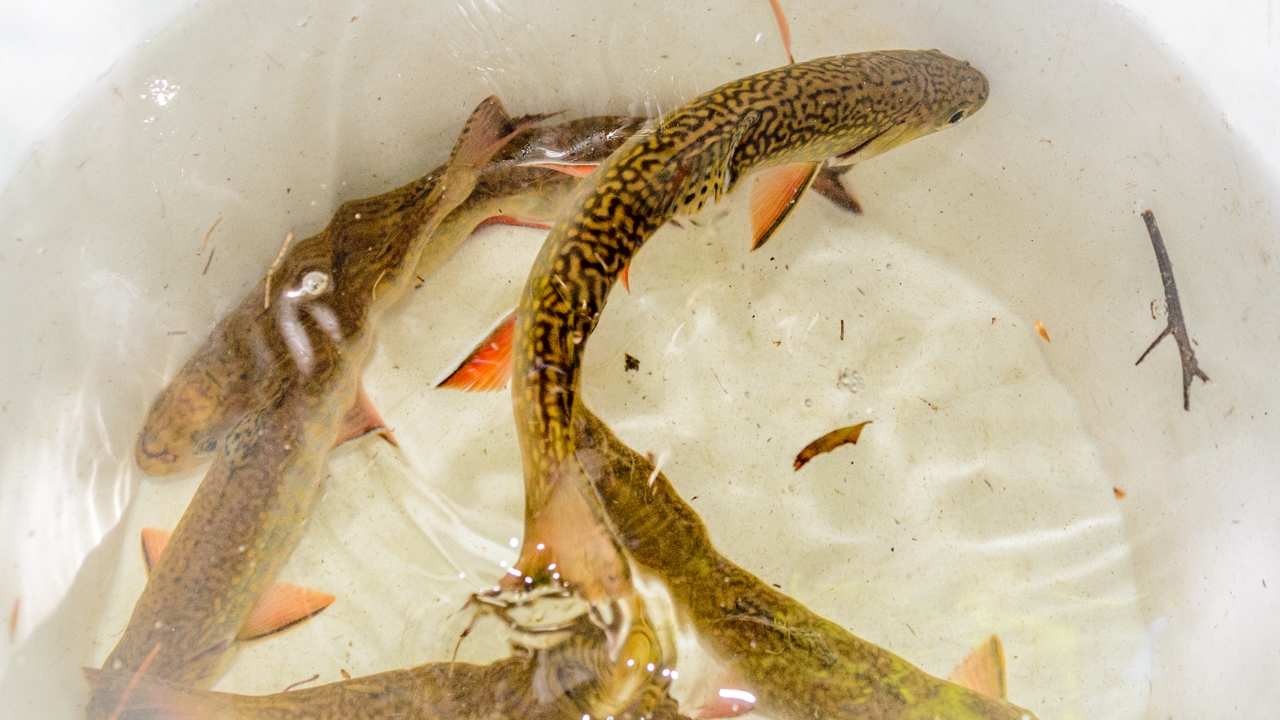
Was anything learned from the hysterical, counterproductive response to Irene? Maybe. Vermont fisheries manager Rich Kirn told me this: “We’ve changed a lot of regulations and developed a rivers training program for state and municipal transportation folks to provide info on how streams work.” In Massachusetts an out-of-court settlement required Hawley and its contractor to partially repair the Chickley River (full repair is impossible). The contractor agreed to pay $225,000, the town $184,000.
In Appalachia hundreds of miles of fragmented brook-trout water is being reconnected by in-stream treatment of acid-mine runoff. With Trout Unlimited activist Bill Thorne of Reedsville, West Virginia I hiked along a recovering section of the state’s Morgan Run to a “doser” — a green silo from which crushed limestone is pulled down by a wheel powered by the flow and therefore dispensed at the appropriate rate. In once-dead Deckers Creek, which flows by Thorne’s house, brook trout now prosper thanks to dosers, limestone channels and settling ponds.
Nowhere has recovery been more successful than on Maine’s Machias and East Machias River systems. Project Share — a coalition of state and federal agencies, landowners, The Nature Conservancy and other NGOs — has saved and restored brook trout by protecting 122,288 watershed acres through purchase and easement. In addition Project Share has restored much of the large woody debris removed during log-drive days, replaced hundreds of hanging culverts and breached dozens of remnant dams.
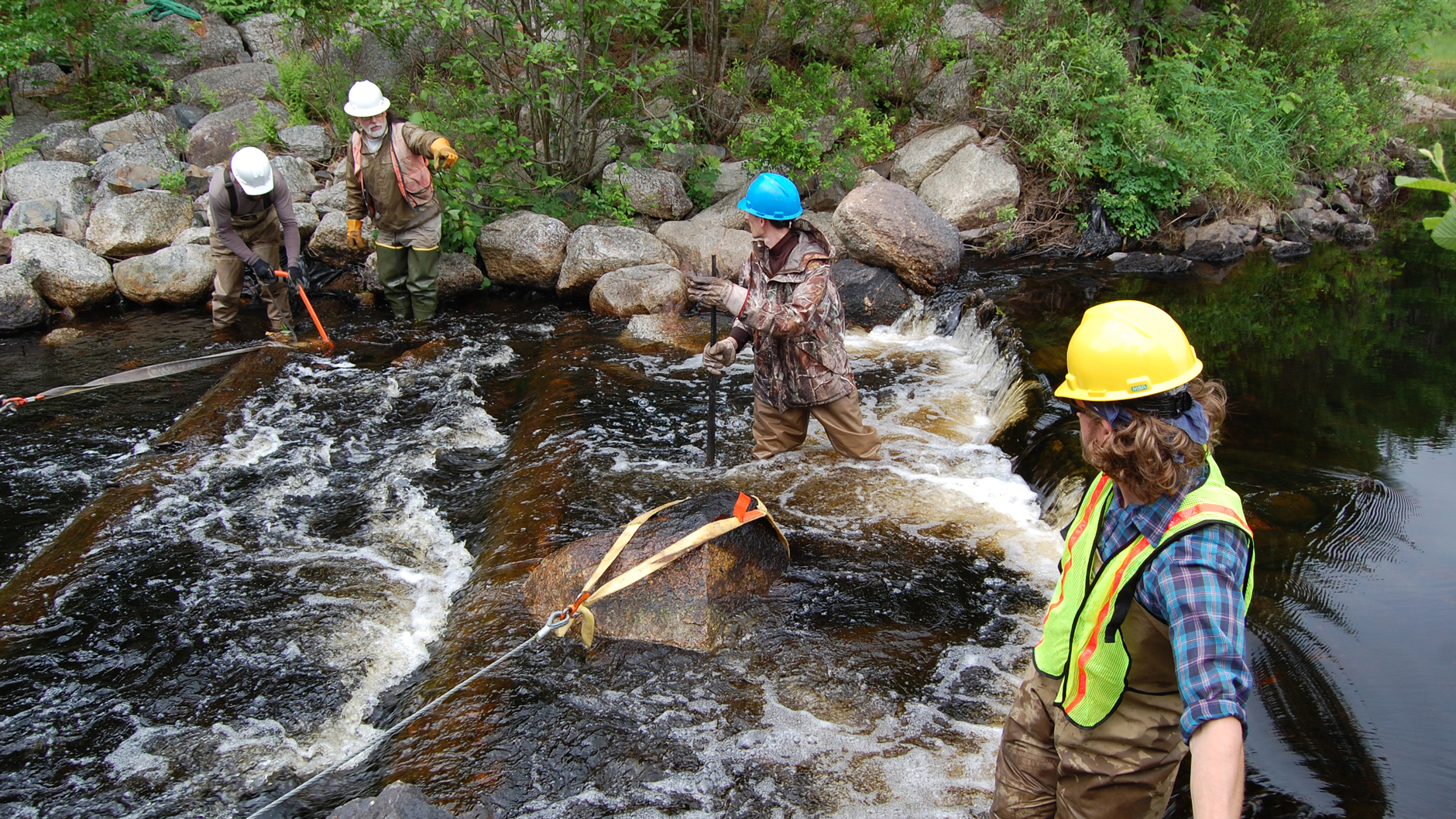
America is starting to understand that fish are wildlife, too. But we need more of what Aldo Leopold called “an ecological conscience.” Most states still defile native-trout water with hatchery-produced aliens, including “Frankenfish” concocted by crossing brook trout with lake trout, brown trout with brook trout, and by culturing pigment-deprived mutants called “golden rainbows” and “palomino trout.”
The dweller of springs is an indicator of land and water health, and its recovery isn’t about one fish. Healthy brook-trout habitat sustains 68 other native species in desperate need of protection. Brook trout are no less important to the East than, say, elk to the West — not because they are beautiful (though they are), not because they are exquisite table fare (though they are), not because they are superb fighters (though they are), not because they are anything. Only because they are.
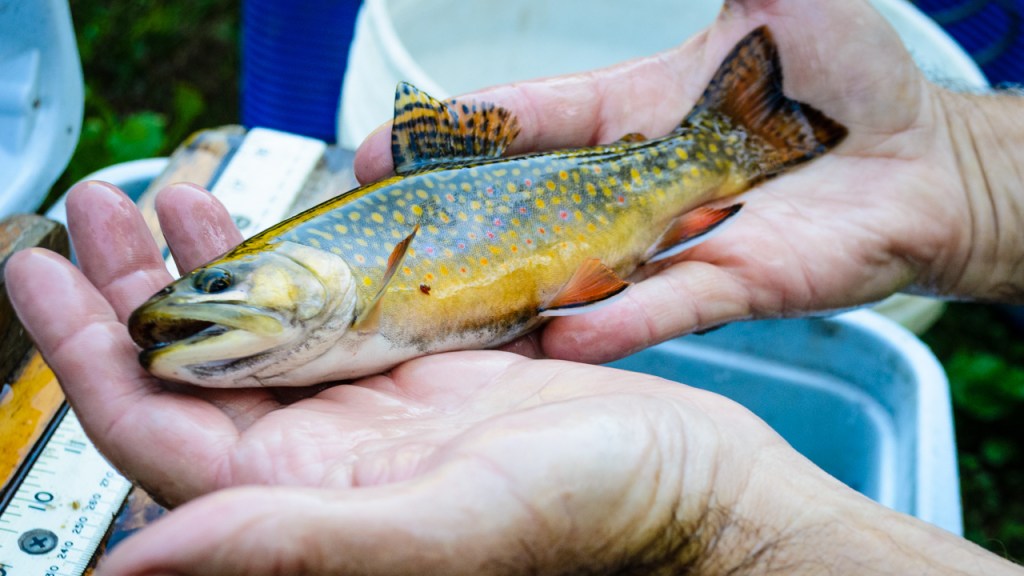



How can the Army Corps of Engineers be convinced that most of their flood control projects in the Appalachian Mtns native trout streams is a disaster for the fish? I am referring specifically to streams in Watauga County , NC and surrounding areas.
Thanks all.
And Gerald. I agree that the fate of the Chickley River in this day and age is unbelievable. And it was just one of hundreds in the wake of Irene. If you haven’t eaten yet and would like to see photos of what the Town of Hawley did to it and read about similar gutterization projects, click on:
http://www.flyrodreel.com/magazine/2012/april/conservation-new
Then, if you click on the photo if the gutterized Chickley, you get a slide show.
Best,
Ted
It’s unbelievable, in this day and age, the Chickley River was channelized after hurricane Irene came through.
Didn’t all the bad press about channelization back in the 1960’s put an end to this flood control practice.
Gerald, after Irene I was as shocked as you. I grew up in the western US, and as a youngster, I participated in a community effort to clean up and restore a degraded stream in the mountain valley my family lived in. My graduate work was in environmental management, focus on water quality. I eventually worked with local government and groups on long-term watershed management. I walked a lot of streams and wetlands, and rode a lot of boats. Came to Vermont to work with the Lake Champlain Basin Program, and though the program was trying, what I saw on the ground was startling to anyone who knew what a natural stream looked like and how it functioned.
Then Irene, and the travesty of the “emergency response”. I heard people talking about “putting the streams back where they belong.” My response is that Irene had allowed streams to take back what rightfully belonged to them. The state suspended permit requirements, which allowed local public works departments to proceed with their “solutions” to the problems as they defined them in 1950s COE terms, i.e. re-channelizing, cutting drainage ditches, building berms. To be fair, some localities made fine decisions. But the awareness was low. By the time the state realized how much damage was being done, and stopped it, there was a lot to be undone. I ached: I love rivers and brooks, having grew up where everyone identified with a river. I love the inhabitants of water, from bugs to fish, birds, otters.
When I first came to Vermont from the land of the rainbow, I often walked along a mountain stream near my home. One day, I heard a fisherman shout with excitement. I turned in his direction, and there were several fisherman gathering around him, all of them grinning. He held up something in his two hands that to me seemed glorious: the first brookie I’d ever seen. He gently unhooked it and slid it back into the water. I understood what the fuss is all about.
As a younger man (38-ish, 1990) I was on my 1st shore duty assignment (Navy) at Groton Sub. Base, CT. and every opportunity led me to the nearest flowing water to cast a fly (mostly dry flies then). Little did I know that those hard fighting Beautiful Brookies (some as large as 12″, but mostly 6 to 9) may of been anadromous roamers !? Makes sense now that You mention it, as many of these flowing waters – incidentally called “Brooks” – flowed into nearby Bays of the Thames, Niantic and Connecticut Rivers. Probably unusual then (?) I could catch a Brookie, Rainbow and Brown trout in stretch of meandering Stream (Brook) less than 300 yards long. Don’t know how they ever “got along” – of course they didn’t, they would each “prefer” different conditions / locations. I was looking at the Groton/New London Google Maps just after reading this article and boy was I surprised ! The build up of Industry after Industry – and of course Right Along these ONCE quiet pristine waters – now engulfed in Pavement and Pollution of all types, including the associated heavy traffic ! Sad, so SAD !
Excellent article, excellent co-operation among groups and individuals and an excellent result already. I want to know more about the entire ecosystem – and the 68 other native species dependent upon the health of the brook-trout. Good going!
Hope we get to look in depth another time at how these efforts truly came about. Me, I’m pretty late to the game. Key players going back more than a decade and not mentioned include Southeastern MA , Cape Cod, and Greater Boston TU Chapters, as well as the larger Red Brook Champions including co-founders Warren Winders, Michael Hopper, Steve Angers, the Lyman Family, the MA/RI TU Council Mass DER, American Rivers, AD Makepeace and many others. Warren’s been at this longer than almost anybody.
But nothing can be said about Red Brook without mentioning Fran Smith.
Without Fran, none of this would have come about. Fran’s leadership and vision single-handedly has transformed trout fishing on Cape Cod – and certainly has inspired habitat restoration in many other places. Along with the thousands of volunteer hours Fran’s CCTU people have put in on the Quashnet, Fran’s dedication has spawned multi-town land conservation efforts and an entire class of fisheries conservationists that without his work wouldn’t know a sea-run trout from a hatchery fish.
I know as I am one.
My book, “Saving Masons Run” is about the efforts to protect and enhance the habitat of southern NJ’s last wild brook trout population. In the most populated state per square mile in the country, it’s a miracle this population still exists.
This article is why I love reading Ted Williams’ work. Outstanding and comprehensive summary of the eastern effort to restore the brook trout across so many states. I am so much more optimistic not than a decade ago when we collectively realized how much ground the Eastern Brook Trout had lost. Stream by stream, state by state, group by group, we are making some real progress, and the restoration work will benefit so much more than one little char.
Ted Williams, thanks summing up why brook trout are important. Within the context of their historic range, what is good for brook trout is good for everything else.
Great piece.. Thanks for all you do..